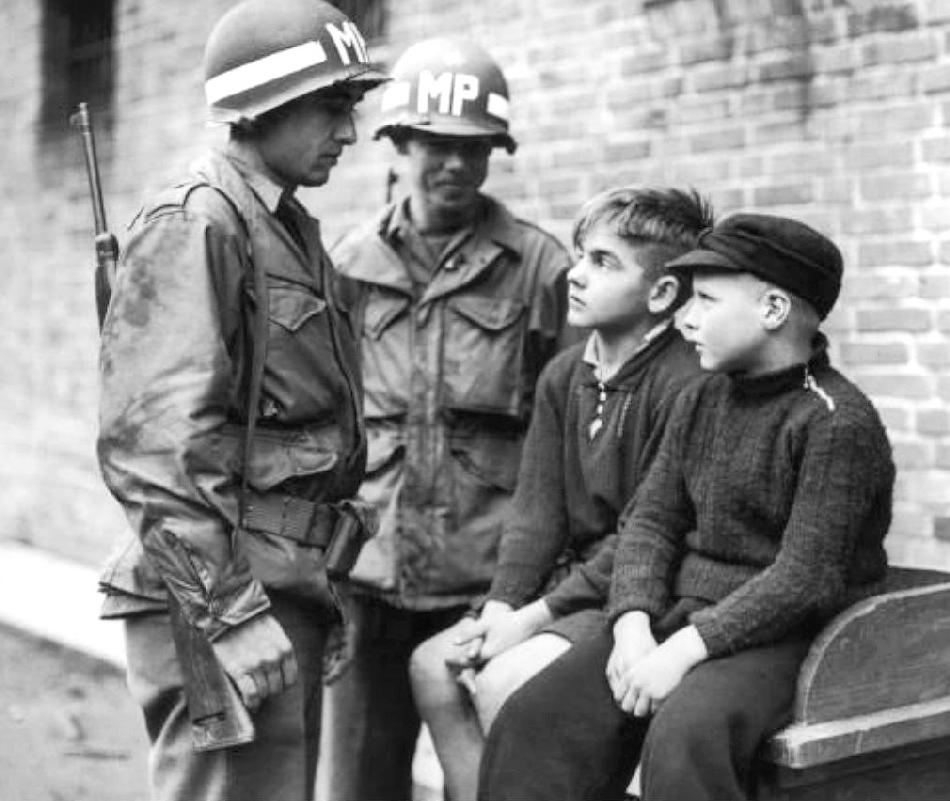
World War II Aftermath: Occupation--NAZI Resistance (1944-46)

Figure 1.--Here American Military Police detain 14-year-old Willy Etschenberg (left) and 10-year-old Hubert Heinrichs (right). The two boys were captured while shooting at U.S. troops following the Allied seizire of Aachen, the first German city to be captured by the Western Allies. The boys told the officers that they had been taught skills as snipers by the Hitlerjugend (Hitler Youth Movement). Aachen was taken October 1944). There were claims made by the Germans that these were Werwolf acitivites. And some attacks in Aachen before the Allies crossed the Rhine may have been atual Werwolf actions. But most acts of resistance such as the sniping the boys here were conducting seem to have been solo actions instigted locally by die-hard NAZIs and nothing to do wth organized resistance. We are not sure if the boys began sniping on their own as a result of basic HJ training (which is possible for the older, but not younger boy) or some adult put them up to it. Someone of course had to provide them weapons. We also do not know what happened to the boys. Photographer: Fred Ramage.
|
|
As the War went irrevocably against Germany with D-Day in the West and Bagration in the East (June-August 1944), it became obvious that Germany had lost the War. None other than SS Reich Führer Heinrich Himmler conceived of Unternehmen Werwolf (Operation Werwolf). He ordered SS Obergruppenführer Hans-Adolf Prützmann to begin organising an unit of elite volunteers to operate secretly behind enemy lines in oocpied areas of the Reich. The initial concept was for Werwolf units to be legitimate uniformed military formations trained to conduct clandestine operations behind enemy lines rather like Allied Special Forces (Commandos). [Klemperer and Watt, p. 305.] Himmler named Prützmann Generalinspekteur für Spezialabwehr (General Inspector of Special Defence). He set up resistance force's headquarters in Berlin and began organising and instructing the officers recruited. Prützmann ws an expert on the guerrilla tactics used by Soviet partisans as aesult of his activities in the NAZI occupied Ukraine. The initial was to use these same tactics for Operation Werwolf. [Biddiscombe] Both Soviet and Allied forces entered the Reich (1944). The rapid disintegration of the Wehrmacht made resiatance forces useless. Soviet partisans were effective, but only because the Wehrmacht failed to destroy the Red Army in 1941 and there were vast rurl and forested areas in whuch to hide. In addition, Hitler refused to even consider the idea of defeat, making planning for resistance in occupied areas impossible and even dangerous as it could be considered defeatist. This is why the Alpine Redoubt came to nothing, making any effective resistance impossible. The planning was further undermined by Propaganda Minister Goebbels who claimed that "The enemy will be taken in the rear by the fanatical population, which will ceaselessly worry him, tie down strong forces and allow him no rest or exploitation of any possible success." Note Goebbels concept was popular resistance by civilians, not elite military units. Near the end of the war, Goebbels gave his Werwolf speech (March 23, 1945). He urged every German to fight to the death. The Western Allies gave considerable weight to the possibility of German resistance, both Operation Werwolf and the Alpine Redoubt. It affected Eisenhower' decesions on troop movements. (Unlike Soviets commanders, Eisenhower had considrable autonomy as to troop movements.) Stalin appears less concerned. From an early point in the War his objective was Berlin. Both Werwolf and the Alpine redoubt were largly fictious. There apper to have been some assainations in Aachen in the Rhineland, the first German city occupied by the Western Allies. Once the Western Allies crossed the Rhine (March 1944) and especially after Hitler shot himself (April 1944), resistance crumbled. Diehrd NAZIs claimed responsibility for a variety of incidents, but few were actual organized Werwolf attacks. Tgere were attacks were what might be described as solo attacks fanatical Nazis or small groups of SS. Tgere were also incidents Hitler Youth boys sniping or engaged in other actions, as far as we know insigated locally by SS members or other die-hard NAZIs. The rapid disappearance of irganized resistance in a nation that so fantically supported the NAZIs is a matter of some interest.
Sources
Biddiscombe, Perry. Werwolf!: The History of the National Socialist Guerrilla Movement, 1944–1946. (University of Toronto Press: 1998).
Klemperer, Victor and Roderick H. Watt. An Annotated Edition of Victor Klemperer's LTI. Notizbuch eines Philologen (E. Mellen Press: 1997).
HBC

Navigate the Boys' Historical Clothing Web Site:
[Return to Main World War II German occupation page]
[Return to Main World War II German aftermath page]
[Return to Main Cold War page]
[About Us]
[Aftermath]
[Biographies]
[Campaigns]
[Children]
[Countries]
[Deciding factors]
[Diplomacy]
[Geo-political crisis]
[Economics]
[Home front]
[Intelligence]
[POWs]
[Resistance]
[Race]
[Refugees]
[Technology]
[Totalitarian powers]
[Bibliographies]
[Contributions]
[FAQs]
[Images]
[Links]
[Registration]
[Tools]
[Return to Main World War II page]
[Return to Main war essay page]
[Return to CIH Home page]
Created: 6:55 AM 3/12/2005
Last updated: 3:03 PM 12/6/2015



